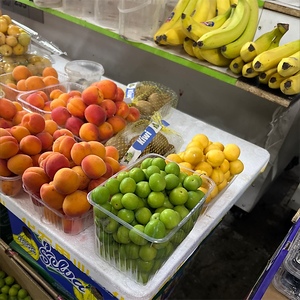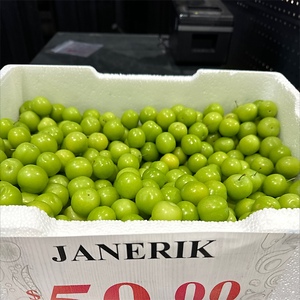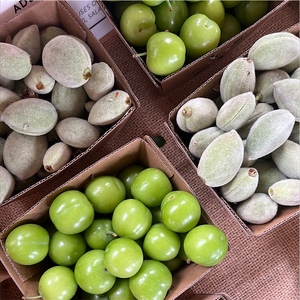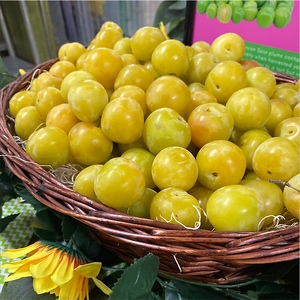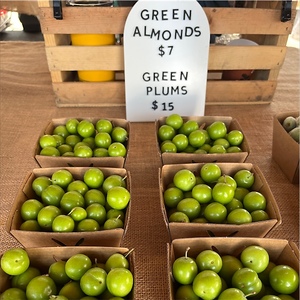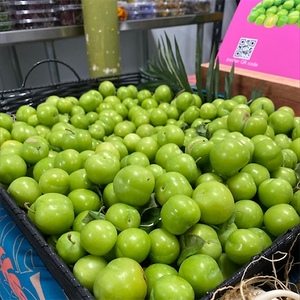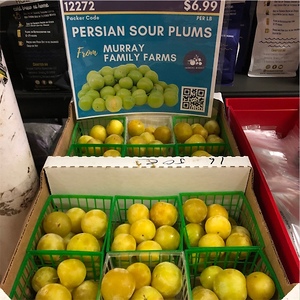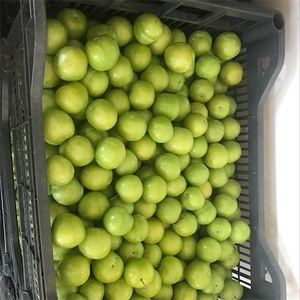

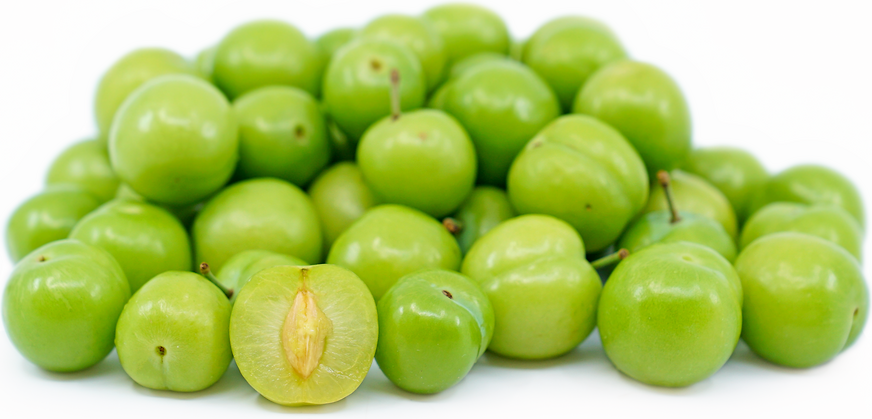
Persian Sour Plums
Estimated Inventory, 8 lbs : 0
Description/Taste
Persian Sour plums are small fruits, averaging 2 to 4 centimeters in diameter, and have a round to slightly oval shape. The plum’s skin is thin, taut, glossy, and smooth, showcasing a bright green hue with a prominent crease down the center of the fruit. Underneath the surface, the pale green flesh is firm, crisp, and dense with a crunchy and semi-aqueous, snap-like consistency. There is also a slender pit found within the center of the flesh. Persian Sour plums contain high acidity when harvested young, contributing to a tart but refreshing sour flavor with green apple and lemon-like, fruity nuances. If the plums are left to mature on the tree, the flesh will soften and ripen into a golden hue, developing a sweet and subtly tangy flavor.
Seasons/Availability
Persian Sour plums are available in the spring.
Current Facts
Persian Sour plums, botanically classified as Prunus cerasifera, are unripe fruits harvested from small deciduous trees belonging to the Rosaceae family. There are many different varieties of unripe green plums generally classified as sour plums, but the descriptor Persian Sour plum is used to encompass the small fruits grown in Iran and other nearby regions in the Middle East. Persian Sour plums are sometimes known as Cherry plums, Myrobalan plums, Persian Green plums, and Unripe plums. The tart fruits are harvested when crunchy, immature, and firm and are favored as a seasonal snack, often balanced in flavor using salt, chile powder, or sugar. In Iran, Persian Sour plums are only available for a short season in the early spring and are valued as a refreshing reprieve to the heavier flavors of winter cuisine.
Nutritional Value
Persian Sour plums are an excellent source of vitamin C to strengthen the immune system, protect against free radical damage to the cells, and reduce inflammation. The plums also provide fiber to regulate the digestive tract and lower amounts of phosphorus, iron, vitamin A, and vitamin K. Beyond vitamins and minerals, the fruits contain citric acid, giving the plums their signature tart and sour flavor.
Applications
Persian Sour plums have a tangy, mouth-puckering flavor well suited for raw and cooked preparations. When raw, the plums can be consumed straight, out-of-hand, and are often sprinkled with salt, chile powder, or dipped in shrimp paste to balance out the sourness. They can also be sliced and served on appetizer platters with hummus, cheeses, and dips, or finely chopped and mixed into sauces, salads, or spreads. Beyond raw preparations, Persian Sour plums can add acidity to dishes in replacement of lemon or vinegar and are popularly mixed into soups, stews, vegetables, and slow-cooked meat dishes. The plums are often utilized in Turkish, Lebanese, Iranian, and Moroccan cuisine and can also be dried for extended use, baked into a soup plum pie, or fermented with sugar to make a sweet and sour liqueur. One of the most famous methods of preserving the crunchy texture of Persian Sour Plums is pickling. The pickled plums transition into a dull, yellow-brown hue, but the fruits retain their crunchy texture and develop spicy, sour, sweet, and salty flavorings. Persian Sour plums pair well with spices such as ginger, cayenne, turmeric, cinnamon, and saffron, tomatoes, red peppers, onions, mushrooms, artichoke, yogurt, goat cheese, and meats such as lamb, poultry, beef, and goat. Fresh, unwashed Persian Sour plums should be immediately consumed for the best quality and flavor. The plums can also be pickled, where they will last for 2 to 4 months when stored properly in the refrigerator.
Ethnic/Cultural Info
Persian Sour plums are a celebrated delicacy in Iran, appearing for a very brief season each spring. The plums are known as Gojeh Sabz, literally translating to “green plums” in Farsi, and the unripe fruits are popularly consumed fresh with salt as a snack or after-dinner palate cleanser. Persian Sour plums are nostalgic fruits for Iranians as the fruits are a refreshing memory of springtime produce. Children favor the sour plums for their tangy taste, and when in season, vendors display the green fruits in large piles along roadsides and in fresh markets. In addition to fresh eating, Persian Sour plums are incorporated into koofteh tabrizi, a type of meatloaf or meatball cooked in a savory beef broth with Persian Sour plums for added acidity. The plums are also cooked into khoresh, a Persian stew with flavorful herbs, traditionally served over rice, or they are dried and coated in salt as a chewy, sweet, salty, and sour snack.
Geography/History
Sour plums are believed by experts to be native to regions of Western Asia and Southeastern Europe and have been growing wild since ancient times. There are many varieties of plums consumed in their unripe, green stage, and the fruits thrive in temperate, cooler climates, having been naturalized throughout Europe, the British Isles, and Eastern Asia. Persian Sour plums specifically originated from the mountainous areas within the cities of Karaj, Tabriz, and Tehran in Iran. Today the tart fruits are also favored for culinary use in Turkey and other regions of the Middle East and are grown on a small scale throughout North America, Australia, Asia, and Europe. When in season, Persian Sour plums can be found through Asian grocers, specialty distributors, online retailers, and local farmer’s markets.
Recipe Ideas
Recipes that include Persian Sour Plums. One
| Family Friends Food |
|
Pickled Green Plums |
| My Persian Kitchen |
|
Unripe Green Plum Stew |
Podcasts



